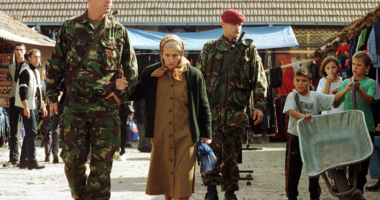The Treaty on the Prohibition of Nuclear Weapons (TPNW) comes into force tomorrow, 22 January 2021. What does that mean, and how did we get here?

| As we close the chapter of 2020, we begin a new year with a historic milestone and a very welcome victory for humanity. The entry into force of the Treaty on the Prohibition of Nuclear Weapons activates the legal effect of the first globally applicable multilateral agreement to comprehensively prohibit nuclear weapons. Rooted in compelling evidence, testimonies of the harm caused by nuclear weapons, the Treaty is the culmination of over seven decades of work by the international community.
Back in August 1945, a matter of weeks after witnessing first-hand the suffering and devastation wrought by the use of nuclear weapons in Hiroshima and Nagasaki, the International Committee of the Red Cross (ICRC) appealed for nuclear weapons to be banned outright, just as poison gas was outlawed in the aftermath of the First World War. A few months later, the United Nations General Assembly called – in its very first resolution – for ‘the elimination from national armaments of atomic weapons and of all other major weapons adaptable to mass destruction’. Since then, a norm prohibiting the use of nuclear weapons has gradually taken shape. The first regional treaty prohibiting nuclear weapons was adopted in 1967 in Latin America and the Caribbean and was followed by four other such treaties covering the South Pacific, Southeast Asia, Africa and Central Asia. The 1968 Nuclear Non-Proliferation Treaty, which remains a cornerstone of nuclear disarmament non-proliferation, not only bars its 186 non-nuclear-armed States Parties from ever acquiring nuclear weapons, but creates an international legal obligation to eliminate nuclear weapons. Meanwhile, efforts to address the humanitarian and environmental impact of nuclear testing led to a partial test-ban in 1963 and the adoption, more than three decades later, of the Comprehensive Nuclear-Test-Ban Treaty. Set against this backdrop of hard-won history, the TPNW’s globally applicable prohibition norm complements the regional nuclear-weapon-free zones that 116 States are party to across the world today. Its unequivocal ban on nuclear testing compensates that of the Comprehensive Nuclear-Test-Ban Treaty which, 25 years after its adoption, has unfortunately yet to enter into force. By providing legal pathways for the elimination of nuclear weapons, moreover, the TPNW is a concrete step towards fulfilling existing nuclear disarmament obligations, notably those under Article VI of the Non-Proliferation Treaty. And importantly, by foreseeing assistance for victims of nuclear testing and use and for remediation of contaminated environments, the Treaty explicitly and directly addresses the catastrophic humanitarian consequences caused by these weapons. |
Team members of the Japanese Red Cross Society were among the first on the scene seeking to alleviate the immense suffering caused by nuclear weapons. Can you describe the experience and how these weapons of mass destruction have impacted and shaped the work of the Japanese Red Cross?
| The Japanese Red Cross Hospital in Hiroshima can be seen as a testament to the resilience of humanity. Located less than two kilometres away from the hypocentre of the nuclear explosion, the hospital’s main structures, while suffering devastating damage, survived the blast on the 6th of August in 1945. What remained of the building was sufficient to raise the Red Cross flag and start providing care for the tens of thousands of bomb survivors.
Three days later, in Nagasaki, the Red Cross team rushed to ground zero to alleviate the suffering of the second bomb’s victims. The unspeakable suffering and devastation witnessed in Hiroshima and Nagasaki would forever mark the Japanese Red Cross Society. Even today, the Japanese Red Cross hospitals continue to treat patients for cancers and illnesses attributable to the atomic bombings of those two cities. This disturbing reality, unbeknownst to many, demonstrates that the effects of nuclear weapons cannot be contained in time. Japan was not, however, the only country to suffer from the effects of nuclear weapons. More than two thousand nuclear tests were carried out after the atomic bombings of Hiroshima, exposing a high number of people to the harmful effects of ionizing radiation. In 1954, the crew on the Japanese fishing boat Daigo Fukuryu Maru was contaminated by nuclear fallout from a nuclear test at Bikini Atoll in the Marshall Islands. The crew suffered acute radiation syndrome and the event drew massive public attention in Japan. Just as the effects of a nuclear detonation cannot be contained it time, it clearly cannot be contained in space either. These are the reasons why the Japanese Red Cross Society and the wider Red Cross and Red Crescent Movement have consistently advocated for the position that nuclear weapons must be prohibited and eliminated. As the former President of the Japanese Red Cross Society, Mr. Tadatsugu Shimazu, wrote in his memoires: ‘One strong belief did never fade away in my mind that even if all other countries hesitate, get bored, or oppose to appeal to people about the fear of nuclear weapons, Japan has to keep doing it and indeed only Japan has the right to do so.’ |
Voices of Hibakusha
Born in Hiroshima, Mrs Setsuko Thurlow was 13 years old when the city was bombed: ‘I vowed that I would do my best to make sure that their death would not be in vain. And for that, we need energy, for that, we need courage’.
Mrs Thurlow dedicated her entire life to advocate for peace, and in 2017 she received the Nobel Peace Prize on behalf of the International Campaign to Abolish Nuclear Weapons (ICAN), stating ‘We didn’t say we wanted revenge, no. We just wanted to make sure no human beings go through that again. Now international law says nuclear weapons are illegal, outlawed and banned. You can imagine how overjoyed we are and what sense of accomplishment we have. I just feel so euphoric about this achievement. We have a lot of work to do. Right now, it’s a prohibition but step by step, it has to get closer to the total abolition. Think, talk, discuss and use your imagination. And once you think you know what this is all about, don’t just stay mute. Use the knowledge you gained. Use it to communicate with political leaders. I know many people find it uncomfortable to be politically involved, but almost everything we do is a political action. We want to pass on a better place to the following generation. That is our obligation to humanity’.
Once in force, what will be the impact of the TPNW on nuclear disarmament and nuclear non-proliferation?

| The entry into force of the TPNW is a momentous achievement and a significant victory for everyone who has advocated for the prohibition and total elimination of nuclear weapons. At the same time, this moment marks a new beginning – not the end – of our efforts. As of today, 86 States have signed and 51 States have also ratified the Treaty. Our work will not be done until all States have joined the Treaty.
It would result in disappointment to expect the TPNW to deliver on a world without nuclear weapons instantaneously. Instead, the Treaty must be seen for what it is: a legal starting point for a long-term effort to achieve comprehensive nuclear disarmament and non-proliferation. This is how international law works. The prohibitions of the TPNW establish a clear standard – a benchmark against which all efforts towards a world without nuclear weapons will be judged. We must now work, over the coming years and decades, to promote adherence to these prohibitions. Every signature and every ratification will bring us closer to realizing the potential of this Treaty. Once in force, the Treaty may also help reduce the risk of nuclear use by further stigmatizing these weapons – by strengthening what has sometimes been referred to as ‘the nuclear taboo’. The Treaty sends a clear signal that any use of nuclear weapons is unacceptable from a moral, humanitarian and now also legal perspective. Such a signal may have an effect beyond the Treaty’s membership. We know that other treaties, while only legally binding upon its parties, have created expectations of behaviour that have also influenced the policies of States not yet party. Looking ahead, the Treaty’s meetings of States Parties, the first of which is to be organized within 12 months of its entry into force, provides opportunities that must not be squandered to amplify this signal. |
What will the International Red Cross and Red Crescent Movement do to promote further adherence to the TPNW?
| The preamble to the TPNW actually recognizes the long-standing efforts of the International Red Cross and Red Crescent Movement to raise awareness amongst the general public of the threats and catastrophic humanitarian consequences of nuclear weapons.
These efforts are rooted in a succession of resolutions and action plans adopted by the Council of Delegates of the Red Cross and Red Crescent under the leadership of President Maurer and then President of the International Federation of Red Cross and Red Crescent Societies, Mr. Tadateru Konoe. The 2017-2021 Movement Action Plan on the Non-use, Prohibition and Elimination of Nuclear Weapons commits the entire Movement to ‘promote adherence to and full implementation of the new Treaty on the Prohibition of Nuclear Weapons by all States, as a crucial step towards the total elimination of nuclear weapons’. While the entry into force of the TPNW is a historic victory, it is indeed important not to forget that this Treaty is a response to the compelling evidence and testimonies of suffering caused by nuclear weapons and a means to ensure that these weapons are never used again. We must continue to raise awareness of the catastrophic humanitarian consequences of nuclear weapons, especially among younger generations. More than 75 years after the atomic bombings of Hiroshima and Nagasaki, there is still no – and probably will never be – adequate humanitarian response capacity to meet the needs of victims of nuclear weapons. As humanitarians, we must continue to ask the uncomfortable question: ‘Who should assist the victims of nuclear detonations, and how?’ The experiences of survivors of past atomic bombings (hibakusha) and nuclear testing remains a central part of these efforts. As an organization uniquely aware of the effects of nuclear weapons, the Japanese Red Cross Society will continue to hand down its experiences to the next generation and contribute to the wider Movement’s efforts in this respect. |
Voices of Hibakusha
Mrs Sakue Shimohira was 10 years old when a nuclear bomb was dropped on Nagasaki. Now 86, she has been telling people who visit the Nagasaki Peace Memorial Museum how she experienced the atomic bombing: ‘As is often said in Japan, “one person’s life is more important than the entire humanity”. We must never allow precious lives to be taken away so mercilessly, regardless of the reason. Even the ones who survived lost the power to keep on living, watched on by others with cold eyes’.
Her mother was killed by the atomic bombing, and her sister committed suicide after suffering from discrimination and poverty. ‘Unless people around the world become aware of the catastrophic and inhumane consequences of nuclear weapons, many more might experience even greater sufferings than Japanese people did. This should never happen, and we should be the last hibakusha in the history’.
See also
- Magnus Løvold, An unnecessary evil: the discursive battle over the meaning of nuclear weapons, August 6, 2020
- Magnus Løvold, Courage, responsibility and the path towards a world without nuclear weapons: a message to youth, August 21, 2019
- Helen Durham, The Treaty on the Prohibition of Nuclear Weapons one year on: Reflections from Hiroshima, September 20, 2018
- Ellen Policinski & Vincent Bernard, Nuclear weapons: Rising in defence of humanity, July 27, 2016








Comments